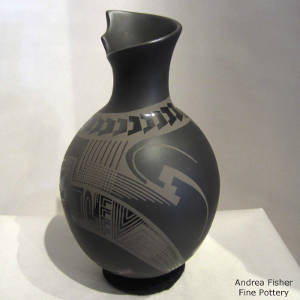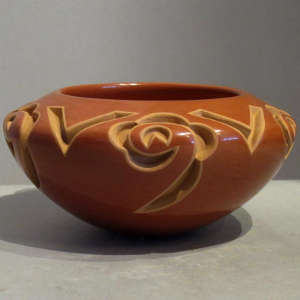Design Elements: Matte and Polished Clay

Sienna rim with cloud design on a polished black plate with a matte black avanyu design, by Maria Martinez and Popovi Da, San Ildefonso
1.75 in H by 9.25 in Dia

Black on black on black vase with an organic opening and Paquimé designs, by Lydia Quezada, Mata Ortiz
11 in H by 6.25 in Dia
Measurement includes stand

Polished red bowl carved with a geometric design outlined with a matte red clay paint, by Effie Garcia, Santa Clara
2.5 in H by 5 in Dia
Maria Martinez is most known for rediscovering how to make polished black pottery at San Ildefonso. Her husband Julian's greatest contribution was his use of beeweed paste to paint what became matte black designs, usually painted in the negative (in the early days of using bee-weed, he painted his designs in the positive), on the surface of her polished pottery before it was fired. His matte paint turned black in the firing.
It was the iron-bearing clay of the slip on the pot itself that determined the final color of the piece. So Maria made them glossy and Julian painted them with matte. Many potters have since used a similar combination (polished red clay painted with matte red paint or a "cameo" effect where the outline of a glossy carving would be painted in a matching matte color).
Lydia Quezada (of Mata Ortiz) is most noted for her development of a matte, semi-matte and polished black process for decorating her distinctively delicate pieces.
Effie Garcia (of Santa Clara) works with her husband, Orville, to form and carve her pieces, sand the carved sections and then outlining those carved sections cameo-fashion with watered clay, which turns matte black when the piece is ground-fired in an oxygen-reduction atmosphere or matte red if it's fired in open air.
Jody Folwell (of Santa Clara) forms many of her pieces and polishes only the upper part around the opening, leaving the rest of the piece matte.
Jemez pottery is often a mix of matte and polished, as exemplified in Maxine Toya's nativity figures.
